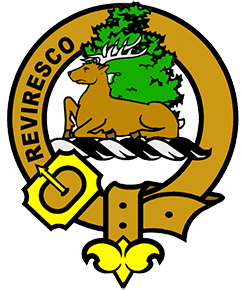Maxwell Clan
Maxwell Clan Crest: A stag couchant before a holly bush.
Maxwell Clan Motto: Reviresco (I flourish again).
History of Clan Maxwell:
Tradition suggests that Maccus, a Norse aristocrat living in the reign of David I was founder of this distinguished Lowland family, and Sir John Maxwell is on record in the 13th century as having been Chamberlain
of Scotland, holding lands in Annandale. Sir John was succeeded by his brother Aymer, whose son swore allegiance to Edward I of England in 1296. Indeed, his son, Sir Eustace, held Caerlaverock Castle at Dumfries
for the English King, but later fought for Robert the Bruce at the Battle of Bannockburn in 1314.
For centuries, the Maxwells were Wardens of the West March and Stewards of Annandale and Kircudbright. Branches of the family include Cardoness, Pollok, Monreith and Farnham.
In 1440, Sir Herbert Maxwell was created Lord Maxwell. The 3rd Lord died at the Battle of Flodden in 1513. The 5th Lord at first conspired with Henry VIII of England, but in 1542, fought for James V at the Battle
of Solway Moss and was taken prisoner.
During the Reformation, the 7th Lord Maxwell corresponded with the King of Spain over the possible restoration of Mary Queen of Scots, but was killed in a dual with the Johnston Family in 1593. In the next generation, the 8th Lord Maxwell shot Sir James Johnston, who was attempting to broker a peace between the two neighbouring factions.
Robert, 9th Lord Maxwell was created Earl of Nithsdale. On the death of the 2nd Earl of Nithsdale, the earldom passed to his kinsman John Maxwell, 7th Lord Herries of Terregles. The 5th Earl was a committed supporter of the Jacobite Cause and taken prisoner at the Battle of Preston in 1715. He was sentenced to death for treason, but with the assistance of his wife, made a spectacular escape from the Tower of London dressed as a servant girl. His titles were forfeit, and on the death of his son, the earldom became extinct. The Lordship of Herries, however, passed through marriage to the family of the Duke of Norfolk.
The Maxwells of Monreith are descended from the 1st Lord Maxwell, and were created baronets in 1681. The Maxwells of Pollok acquired the Lordship of the Mearns, including Upper Pollok, in the 13th century. Pollok House was erected by Sir John Maxwell in 1752.
Places of Interest: Caerlaverock Castle, Dumfries. Thirteenth century fortification which belonged to the Lordship of Maxwell. It was besieged by Edward I in1300, and by Covenanters in 1638,
Merkland Cross, Dumfries. The Master of Maxwell was murdered on this spot in 1484.
Threave Castle, Castle Douglas, Dumfriesshire. The Maxwell earls of Nithsdale were appointed Hereditary Keepers by the House of Douglas.
Monreith Tower, Whithorn, Wigtownshire. This was owned by the Maxwells. A memorial to the author Gavin Maxwell is situated overlooking Monreith Bay.
Myreton Castle, Port William, Wigtownshire. Acquired by the Maxwells of Monreith from the McCullochs in 1685. Now in ruins.
Pollok House, Glasgow. Built for Sir John Maxwell in 1752, it was designed by William Adam (although finished by his sons), and was presented to the City of Glasgow by the Stirling-Maxwell Family in 1967.
Newark Castle, Port Glasgow. This was acquired by the Maxwells in 1402.
Haggs Castle, Govan, Renfrewshire. Built by the Maxwells in 1585. Although a ruin, it has been partially restored.
Surname distribution in Scotland: The Maxwell name is most commonly found in Lanarkshire, Dumfries and Galloway (Dumfriesshire, Kirkcudbrightshire and Wigtownshire), Ayrshire, Glasgow City, Dunbartonshire, Stirlingshire and Fife.
Associated family names (Septs): Adair, Blackstock, Dinwiddie, Edgar, Herries, Kirk, Kirkland, MacKittrick, Maxton, Monreith, Moss, Nithsdale, Peacock, Pollock, Pollok, Sturgeon, Wardlaw.
Clan Maxwell membership certificates.

